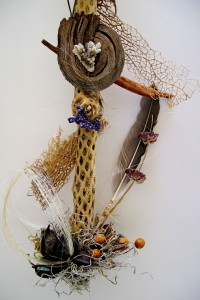With great respect for the Indigenous Peoples, I have adapted a few of their spiritual practices for art therapy. I do not mean to make light of or to dishonor any sacred rights or beliefs.
Prayer sticks are used in various religions, not only Native American, but also Buddhism and Wiccan.
As a person who is a certified Interfaith Spiritual Director, I have studied world-wide religions. I have done so as part of my own personal quest for a deeper connection to spirit. I have also studied interfaith religions to be fully present for the spiritual or religious practices of those who enter my office.
For some, counseling helps heal childhood religious or spiritual abuse, so that the person is able to return to the religion of their birth with a renewed sense of awe and commitment.
There are cases where the religious or spiritual breach is too profound for a return to the religion of youth. One of the greatest tragedies of sexual abuse by religious leaders is the profound negative spiritual block it creates inside of a child.
This is especially true for those who have been abused by deviant social movements and/or religious cults. The pain and betrayal caused by the perpetrators are often associated with or attached to the spiritual, God, or Higher Power concept.
In these cases, rebuilding broken trust in spirit can be a delicate process.
Most often, nature is a safe pathway to rekindle the light in a broken soul. Then it follows that ancient religions grounded in a love of and respect for nature have something to teach us.
Decades ago I began to ask clients to make a personal version of a prayer stick. Prayer sticks may be used to assist in prayer and meditation. This is especially helpful for newly sober addicts in 12-step recovery.
Wikipedia states that prayer sticks are used as offerings. In my own practice, I liken prayer sticks to a positively charged lightening rod. It seems as if prayer sticks help forge an easier and deeper felt sense of connection to spirit. Prayer sticks help burn away the dross and the distractions from the practice of prayer and meditation.
Most people who are facing addiction or trauma have trouble with focus and concentration. Hand held objects help anchor the attention.
My directives are very simple.
First I ask a client to collect objects of nature while hiking. I ask them to collect objects that attract them, objects that open their hearts.
Then I ask clients (or workshop participants) to experiment with the arrangement or juxtaposition of these objects so that it feels right. I explain that the felt sense of what is right does not have to make logical sense. What is most important that the prayer sticks are made with a reverent intention. In fact, praying while constructing a prayer stick is very important.
The process of making a prayer stick is a form of what I call, “active meditation”.
Once made, the prayer sticks may be held during prayer and meditation. If that is too distracting, then the prayer sticks may be placed near a meditation pillow or on an altar.
These personally made and often beautiful prayer sticks are able to help ground and connect the distracted mind or hurt soul.
In a small way, isn’t this what healing and transformation is all about?

